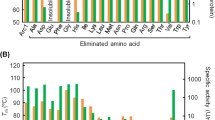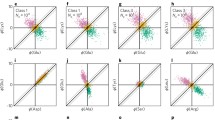Summary
In at least two instances involving serine proteinase inhibitors it has been shown that functionally important sites evolve faster and exhibit more interspecific variability than functionally neutral sites. Because these phenomena are difficult to reconcile with the neutral theory of molecular evolution, it has been suggested that the accelerated rate of amino acid substitution at the reactive sites is brought about by positive Darwinian selection. We show that differences in the amino acid composition in the different regions of proteinase inhibitors can account for the differences in the rates of amino acid substitution. By using an index of protein mutability [D. Graur (1985) J Mol Evol 22∶53–62], we show that the amino acid composition of the reactive center in the ovomucoids andSpi-2 gene products is such that, regardless of function, they are expected to evolve more rapidly than any other polypeptide for which the rate of substitution is known. In addition, the reactive region in theSpi-2 proteins is shown to be free of compositional constraint. Positive Darwinian selection need not be invoked at the present time in these cases.
Similar content being viewed by others
References
Barrett AJ, Salvesen G (eds) (1986) Proteinase inhibitors. Elsevier, Amsterdam
Barrett AJ, Nicklin MJH, Rawlings ND (1984) The papain super family of cysteine proteinases and their protein inhibitors. In: Elödi P (ed) Proteinase action. Akadémiai Kiadó, Budapest, pp 203–217
Brown AL (1987) Positively Darwinian molecules? Nature 326: 12–13
Chandra T, Stackhouse R, Kidd VJ, Robson KJH, Woo SLC (1983) Sequence homology between human α1-antichymotrypsin, α1-antitrypsin and antithrombin III. Biochemistry 22: 5055–5060
Clarke B (1970) Selective constraints on amino-acid substitution during the evolution of proteins. Nature 228:159–160
Creighton TE, Charles IG (1987) Sequences of the genes and polypeptide precursors for two bovine protease inhibitors. J Mol Biol 194:11–22
Dickerson RE, Geis I (1983) Hemoglobin: structure, function, evolution and pathology. Benjamin/Cummings, Menlo Park CA
Fioretti E, Iacopino G, Angeletti M, Barra D, Bossa F, Ascoli F (1985) Primary structure and antiproteolytic activity of a Kunitz-type inhibitor from bovine spleen. J Biol Chem 260: 11451–11455
Gojobori T, Li W-H, Graur D (1982) Patterns of nucleotide substitution in pseudogenes and functional genes. J Mol Evol 18:360–369
Grantham R (1974) Amino acid difference formula to help explain protein evolution. Science 185:862–864
Graur D (1985a) Amino acid composition and the evolutionary rates of protein coding genes. J Mol Evol 22:53–62
Graur D (1985b) Pattern of nucleotide substitution and the extent of purifying selection in retroviruses. J Mol Evol 21: 221–231
Hill RE, Hastie ND (1987) Accelerated evolution in the reactive centre regions of serine protease inhibitors. Nature 326:96–99
Hill RE, Shaw PH, Boyd PA, Baumann H, Hastie ND (1984) Plasma protease inhibitors in mouse and man: divergence within the reactive centre. Nature 311:175–177
Jukes TH, King JL (1971) Deleterious mutations and neutral substitutions. Nature 231:114–115
Kato I, Schrode J, Kohr WJ, Laskowski M (1987) Chicken ovomucoid: determination of its amino acid sequence, determination of the trypsin reactive site, and preparation of all three of its domains. Biochemistry 26:193–201
Kimura M (1968) Evolutionary rate at the molecular level. Nature 217:624–626
Kimura M (1983) The neutral theory of molecular evolution. Cambridge University Press, Cambridge
Klein J, Figueroa F (1986) Evolution of the major histocompatibility complex. CRC Crit Rev Immunol 6:295–386
Laskowski M, Kato I, Ardelt W, Cook J, Denton A, Empie MW, Kohr WJ, Park SJ, Parks K, Schatzley BL, Schoenberger OL, Tashiro M, Vichot G, Whatley HE, Wieczorek A, Wieczorek M (1987a) Ovomucoid third domains from 100 avian species: isolation, sequences, and hypervariability of enzyme-inhibitor contact residues. Biochemistry 26:202–221
Laskowski M, Kato I, Kohr WJ, Park SJ, Tashiro M, Whatley HE (1987b) Positive Darwinian selection in evolution of protein inhibitors of serine proteinases. Cold Spring Harbor Symp Quant Biol 52 (in press)
Li W-H, Wu C-I, Luo C-C (1985) A new method for estimating synonymous and nonsynonymous rates of nucleotide substitution considering the likelihood of nucleotide and codon changes. Mol Biol Evol 2:150–174
Miyata T, Miyazawa S, Yasunaga T (1979) Two types of amino acid substitution in protein evolution. J Mol Evol 12:219–236
Nei M (1975) Molecular population genetics and evolution. North Holland, Amsterdam
Nei M, Graur D (1984) Extent of protein polymorphism and the neutral mutation theory. Evol Biol 17:73–118
Nie NH, Hull CH, Jenkins JG, Steinbrenner K, Bent DH (1975) SPSS. McGraw-Hill, New York
Read RJ, James MNG (1986) Introduction to the protein inhibitors: x-ray crystallography. In: Barrett AJ, Salvesen G (eds) Proteinase inhibitors. Elsevier, Amsterdam, pp 301–336
Schreier PH, Bothwell ALM, Mueller-Hill B, Baltimore D (1981) Multiple differences between the nucleic acid sequence of the IgG2a and IgG2ab alleles of the mouse. Proc Natl Acad Sci USA 78:4495–4499
Shepard HW, Gutman GA (1981) Allelic forms of ratk chain genes: evidence for strong selection at the level of nucleotide sequence. Proc Natl Acad Sci USA 78:7064–7068
Yoon J-B, Towle HC, Seelig S (1987) Growth hormone induces two mRNA species of the serine protease inhibitor gene family in rat liver. J Biol Chem 262:4284–4289
Author information
Authors and Affiliations
Rights and permissions
About this article
Cite this article
Graur, D., Li, WH. Evolution of protein inhibitors of serine proteinases: Positive Darwinian selection or compositional effects?. J Mol Evol 28, 131–135 (1988). https://doi.org/10.1007/BF02143504
Received:
Revised:
Issue Date:
DOI: https://doi.org/10.1007/BF02143504




